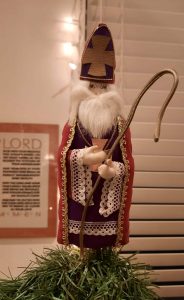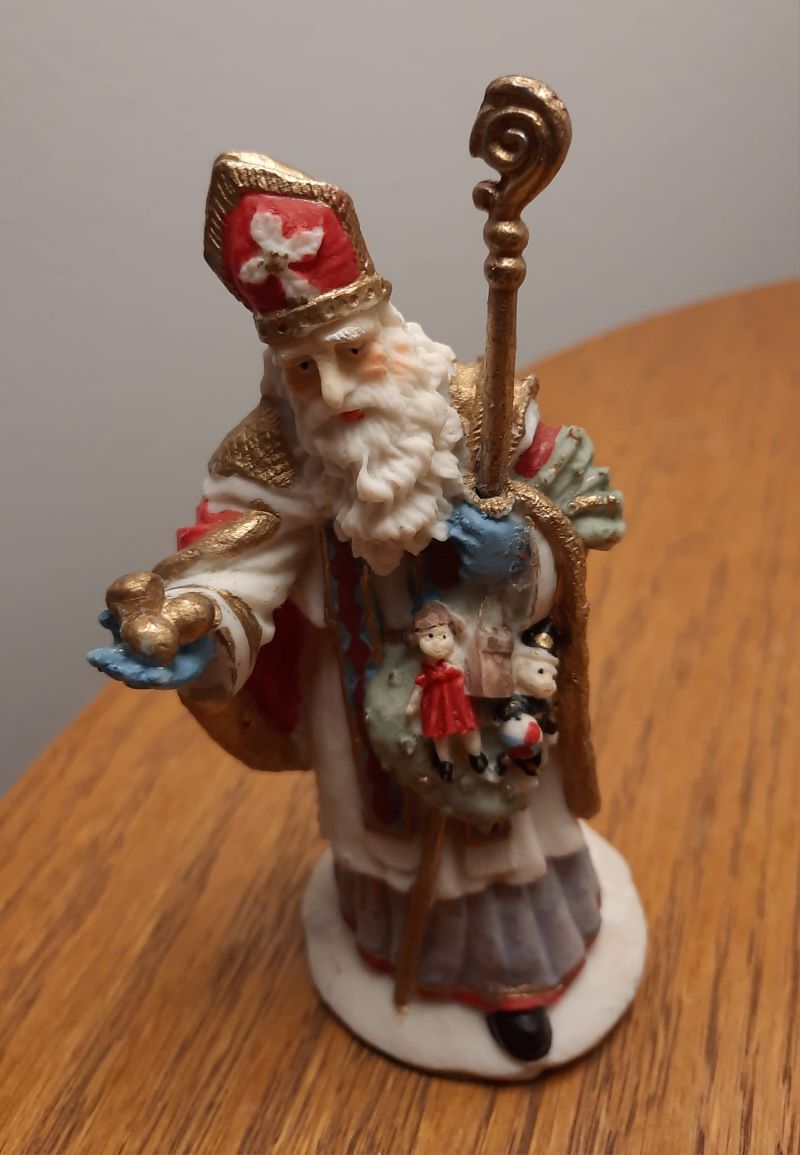There are many stories, indeed legends about the beloved and popular St. Nicholas. Most of these stories cannot be verified as very little is known about his life. What we do know is that Nicholas was born sometime in the third century near Myra in modern day Turkey. He became a Bishop of the church and may have been present at the Council of Nicaea in 325. He suffered torture and imprisonment during the persecution of Christians under the Emperor Diocletian and died around 342. Bishop Nicolas gave away much of his inherited wealth and became known for helping people in secret. Subsequently, he was honored as a saint in Constantinople in the sixth century. His feast day is December 6th. He is still celebrated as the patron of children and also seafarers and sailors. St. Nicolas, as a bearer of Christmas gifts to children, was brought to America by Dutch colonists in New York. In The Netherlands his name was Sinter Claus. Sinter Claus soon evolved into the popular name, Santa Claus. (Source: Lesser Feasts and Fasts, Episcopal Church Publishing, 1997) The cover photo is a figurine of The Netherlands’, Sinter Claus from The International Santa Claus Collection.
I was introduced to St. Nicholas by my parents at the age of five. Having learned about Santa Claus in kindergarten, I asked my parents about him. I was told that Santa was a lovely story but that he did not exist. I remember being very disappointed! However, my parents were quick to tell me about St. Nicholas.
On the night of December 5th, my parents began the Dutch tradition of having my brothers and me place a pair of empty shoes in front of our bedroom doors. We were told that St. Nicholas was coming. And, it came to pass! In the morning, on December 6, we found that our empty shoes were filled with gifts. Additionally, we also received a teaching from my father which I have never forgotten. He said, “On St. Nicholas Day we receive secret gifts but on Christmas Day we exchange gifts to celebrate the birth of Christ by loving and sharing with one another.”
No doubt this teaching stemmed from the fact that Bishop Nicholas traveled the countryside helping the poor and sick. One of the best-known stories about St. Nicholas is that he provided money for dowries for three poor sisters so that they could be married. Without the dowries, their father might have been forced to sell them into slavery or prostitution. For three nights, Bishop Nicholas left three bags of gold for each of the girls in front of their home. During the winter holidays, you might see little net bags of gold coins which are chocolates, being sold. St. Nicholas inspired this tradition.
From my perspective, delighting in receiving secret gifts on St. Nicholas Day and saving Christmas for Christ, is a good practice. I have handed down the tradition to my children and grandchildren. I enjoyed sharing the tradition of St. Nicholas in the congregations where I served as a priest and pastor before I retired. One year I was gifted with a hand-made St. Nicholas tree-top ornament. Bishop Nicholas in this image appears in the traditional church vestments and Advent colors. He has been placed at the top of my Advent Tree every year since 1988. It gives me great joy!

Perhaps because I did not grow up writing letters to Santa Claus or having my picture taken on his lap in stores, I confess that I was a bit smug about Santa Claus and the cultural hype around his celebration. Most ornaments on my tree are of a religious nature. I have a gift bag that reads, “Jesus is the Reason for the Season.” There are angels, images of Mary and Joseph, Jesus in the manger, even an ornament of St. John the Baptist. I was proud of my allegiance to Christ and the church during the season of Christmas.
However, a few years ago, I was gifted with many figurines from “The International Santa Claus Collection.” I learned that the tradition and celebration of St. Nicholas or Santa Claus at the time of Christmas exists in one form or another throughout the world. All of these cultural figures are devoted to the idea of gift giving, particularly to children. The figurines I own also include those who carry the message of love embodied by both older women and young girls as well as angels. I appreciate the fact that in some cultures, women bring the Spirit of Christmas love into people’s lives!

Perhaps the Spirit of God is more inclusive than we might imagine. Perhaps this same Spirit operates through the signs and symbols of many religious faiths and secular traditions. This is surely something to celebrate and give thanks for. In a world where it is often difficult to see love in action, I pause and pray with my International Santa Claus Collection. I give thanks that people across the globe in different cultures and circumstances might know and experience the transformative power of love through their many symbols of Christmas.
Ironically, the International Santa Claus Collection which I inherited does not include a representation of the traditional Santa Claus of the United States. However, having repented of my bias toward the American Santa Claus, I have purchased one and eagerly await his arrival so that I can add him to the collection.
In the Episcopal Church, a portion of the prayer that is offered for St. Nicolas on his feast day of December 6th, is a call for others to follow his example:
“May we be so inspired by the example of your servant Nicholas of Myra, that we never cease to work for the welfare of children, the safety of sailors, the relief of the poor, and the help of those tossed by tempests of doubt or grief.”
In honor of St. Nicholas this year, may we accept the invitation of Christ to perform some act of loving kindness for another in need, be it a financial gift or some other act of charity. An act of loving kindness can be as simple as greeting a stranger in a store or in the street with a kind word and a gracious smile. Jesus is indeed the reason for the season. Like St. Nicholas may we embody those words with concrete actions of love.

LAST FEW DAYS TO SIGN UP.
December 9, An Advent Quiet Day Retreat with Christine Sine.
Join Christine for a virtual retreat celebrating quiet anticipation and focusing on experiencing a meaningful Christmas. She will lead a morning of scripture reading and quiet reflection that will be for many of us a much needed oasis of quiet in the midst of this chaotic season. Register to participate here.

